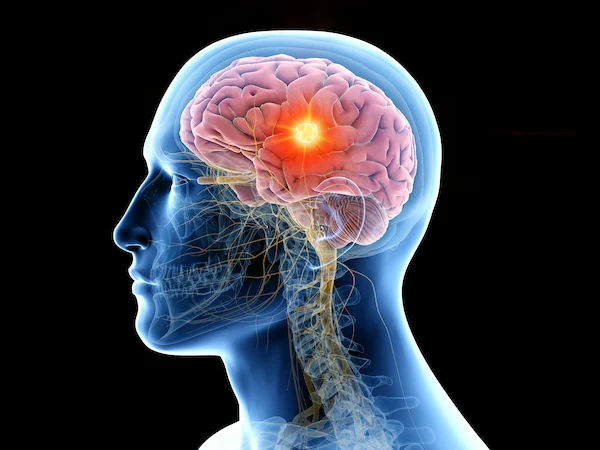All About Brain Tumors: Types, Causes, Symptoms, and Treatment
Learn about brain tumors: their types, causes, symptoms, diagnosis, and treatment options. Get comprehensive information on this complex condition.

Written by Dr.Sonia Bhatt
Last updated on 3rd Jul, 2025

Brain tumours are abnormal growths of cells within the brain or its surrounding structures. They can be either benign (non-cancerous) or malignant (cancerous). Brain tumours can originate in the brain (primary brain tumours) or spread to the brain from other parts of the body (secondary or metastatic brain tumours). The impact of brain tumours on an individual's health and quality of life can vary significantly depending on their size, location, and type. This article provides a comprehensive overview of brain tumours, including their types, symptoms, diagnosis, and treatment options.
Types of Brain Tumors
Brain tumours are classified into two main categories: primary and secondary.
Primary Brain Tumors:
Gliomas: A diverse group of tumours originating from glial cells, which support nerve cells in the brain. Subtypes include:
Astrocytomas: Arise from astrocytes, star-shaped glial cells.
Oligodendrogliomas: Develop from oligodendrocytes, which create the myelin sheath surrounding nerve fibres.
Glioblastomas: The most aggressive and common form of primary brain tumors in adults, arising from astrocytes.
Meningiomas: These tumours develop from the meninges, the protective membranes covering the brain and spinal cord. Most meningiomas are benign but can cause significant issues due to their location.
Pituitary Adenomas: Benign tumors that develop in the pituitary gland, affecting hormone production and potentially causing symptoms related to hormonal imbalances.
Craniopharyngiomas: Benign tumours that develop near the pituitary gland, often affecting vision, growth, and hormone levels.
Schwannomas: Benign tumors that develop from Schwann cells, which produce the myelin sheath covering nerves. The most common type is acoustic neuroma, which affects the nerve responsible for hearing and balance.
Medulloblastomas: Malignant tumors primarily found in the cerebellum, common in children. They can spread to other parts of the central nervous system.
Ependymomas: Tumors that develop from ependymal cells lining the ventricles of the brain and the central canal of the spinal cord. They can be benign or malignant.
Germ Cell Tumors: Rare tumours that originate from germ cells, which form eggs or sperm. These tumours can occur in the brain and other parts of the body.
Pineal Region Tumors: Tumors located in or around the pineal gland, which is involved in hormone regulation, such as melatonin production. These can be benign or malignant.
Olfactory Neuroblastomas: Tumors that arise in the olfactory region of the nasal cavity, affecting the sense of smell. These are also known as esthesioneuroblastomas and can be aggressive.
Secondary (Metastatic) Brain Tumors:
Secondary brain tumours originate in other parts of the body, such as the lungs, breasts, or kidneys, and spread to the brain. They are always malignant and are more common than primary brain tumours.
Symptoms of Brain Tumors
The symptoms of brain tumours can vary depending on the tumour's size, location, and rate of growth. Common symptoms include:
Headaches: Frequent and severe headaches that may worsen with activity or in the morning.
Seizures: Sudden, uncontrolled electrical activity in the brain, leading to convulsions or loss of consciousness.
Nausea and Vomiting: Persistent nausea and vomiting, especially in the morning.
Vision Problems: Blurred vision, double vision, or loss of peripheral vision.
Hearing Problems: Hearing loss or ringing in the ears (tinnitus).
Balance and Coordination Issues: Difficulty walking, maintaining balance, or coordinating movements.
Weakness or Numbness: Weakness or numbness in the limbs, face, or one side of the body.
Cognitive and Behavioral Changes: Memory loss, confusion, difficulty concentrating, personality changes, or mood swings.
Speech Difficulties: Difficulty speaking, understanding language, or finding the right words.
Hormonal Imbalances: Changes in hormone levels leading to symptoms such as weight gain, fatigue, or menstrual irregularities.
Diagnosis of Brain Tumors
Diagnosing a brain tumour involves a combination of medical history, physical examination, and diagnostic tests. Common diagnostic tools include:
Imaging Studies: MRI and CT scans are commonly used to visualise the brain and detect the presence of a tumour. MRI provides detailed images of brain structures, while CT scans can quickly identify abnormalities.
Biopsy: A sample of the tumour tissue is obtained and examined under a microscope to determine the type and grade of the tumour. A biopsy can be performed through surgery or a less invasive procedure called stereotactic needle biopsy.
Neurological Examination: A series of tests to assess brain function, including reflexes, muscle strength, coordination, and sensory perception.
Blood Tests: Blood tests may be performed to check for hormonal imbalances or other abnormalities that could indicate the presence of a brain tumour.
Treatment of Brain Tumors
The treatment of brain tumours depends on several factors, including the type of tumour, its size, location, and grade, as well as the patient's overall health. Here is a detailed overview of the various treatment options available for brain tumours:
1. Surgery
Surgery is often the primary treatment for brain tumours, especially if the tumour is accessible and can be safely removed. The goal of surgery is to remove as much of the tumour as possible while minimising damage to surrounding brain tissue. Types of surgery include:
Craniotomy: A surgical procedure where a portion of the skull is removed to access the brain and remove the tumour. The skull is then replaced after the tumour is removed.
Endoscopic Surgery: A minimally invasive procedure that uses an endoscope (a thin, flexible tube with a camera) to remove the tumour through small incisions.
Laser Ablation: A technique that uses laser energy to destroy tumour cells. It is often used for tumours that are difficult to reach with traditional surgery.
2. Radiation Therapy
Radiation therapy uses high-energy beams to target and destroy cancer cells. It is often used in combination with surgery or as the primary treatment for inoperable tumours. Types of radiation therapy include:
External Beam Radiation Therapy (EBRT): The most common form of radiation therapy, where radiation is delivered from a machine outside the body.
Intensity-Modulated Radiation Therapy (IMRT): An advanced form of EBRT that allows for precise targeting of the tumour while minimising damage to surrounding healthy tissue.
Stereotactic Radiosurgery (SRS): A highly precise form of radiation therapy that delivers a single high dose of radiation to the tumour. It is often used for small, well-defined tumours.
3. Chemotherapy
Chemotherapy uses drugs to kill cancer cells or stop their growth. It is often used in combination with surgery and radiation therapy. Chemotherapy can be administered orally, intravenously, or directly into the cerebrospinal fluid. Common chemotherapy drugs used for brain tumours include:
Temozolomide (Temodar): An oral chemotherapy drug commonly used to treat glioblastomas.
Carmustine (BCNU): A chemotherapy drug that can be administered intravenously or as an implant placed in the brain during surgery.
Bevacizumab (Avastin): A targeted therapy drug that inhibits the growth of blood vessels that supply the tumour.
4. Targeted Therapy
Targeted therapy involves using drugs that specifically target cancer cells while sparing normal cells. These drugs work by interfering with specific molecules involved in tumour growth and progression. Examples of targeted therapy drugs for brain tumours include:
Everolimus (Afinitor): A drug that targets the mTOR pathway, which is involved in cell growth and proliferation.
Erlotinib (Tarceva): A drug that targets the epidermal growth factor receptor (EGFR) pathway, which is often overactive in certain types of brain tumours.
5. Immunotherapy
Immunotherapy helps the body's immune system recognize and attack cancer cells. It is an emerging treatment option for certain types of brain tumours. Types of immunotherapy include:
Immune Checkpoint Inhibitors: Drugs that block proteins that prevent the immune system from attacking cancer cells. Examples include pembrolizumab (Keytruda) and nivolumab (Opdivo).
Cancer Vaccines: Experimental vaccines that stimulate the immune system to recognize and attack cancer cells are being studied in clinical trials.
6. Tumor Treating Fields (TTF)
Tumor Treating Fields (TTF) is a novel treatment that uses electric fields to disrupt the division of cancer cells. It is delivered through a device worn on the scalp and is often used in combination with other treatments for glioblastomas.
7. Supportive Care
Supportive care focuses on managing symptoms and improving quality of life for patients with brain tumours. This may include:
Medications: To control pain, seizures, and swelling.
Physical Therapy: To help patients regain strength and mobility.
Occupational Therapy: To assist with daily activities and improve independence.
Speech Therapy: To address speech and language difficulties.
Nutritional Support: To ensure patients maintain adequate nutrition.
Conclusion
Brain tumours are a serious medical condition that can significantly impact an individual's health and quality of life. Early diagnosis and prompt treatment are crucial for improving outcomes and managing symptoms. If you experience persistent symptoms such as headaches, seizures, or cognitive changes, it is important to seek medical attention for proper evaluation and management.
Consult Top Neurologists
Consult Top Neurologists
Dr. Lakshaman K
Neurologist
19 Years • MBBS,MS General Medicine,MCH Neurosurgery
Bengaluru
R V speciality Clinic, Bengaluru

Dr. Uddalak Chakraborty
Neurologist
8 Years • MBBS, MD(GENL.MED.),DM(NEUROLOGY)
Kolkata
MCR SUPER SPECIALITY POLY CLINIC & PATHOLOGY, Kolkata

Dr. Joydeep Biswas
Neurologist
15 Years • MBBS, DNB General Medicine, DNB Neurology
Barasat
Diab-Eat-Ease, Barasat

Dr. Swapnil Jain
Neurologist
7 Years • MBBS, MD (General medicine) , DNB Neurology
Jaipur
Tooth n brain clinic, Jaipur

Dr. Arunesh
Neurologist
14 Years • MD INTERNAL MEDICINE / FELLOWSHIP IN NEUROLOGY
Jabalpur
NEURO EXPERT CLINIC, Jabalpur